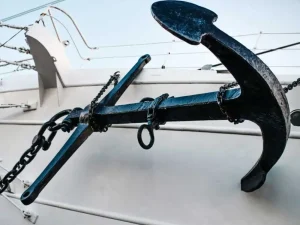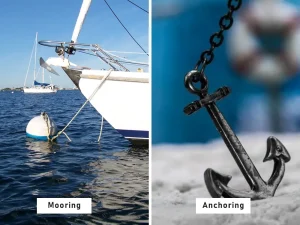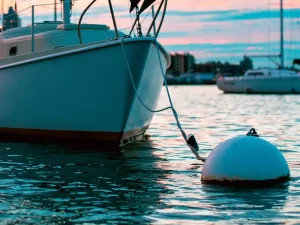Festmachen und Ankern sind zwei beliebte Tätigkeiten in der Schifffahrt. Sie tragen dazu bei, dass Boote und Schiffe an einem Punkt stationär und stabil bleiben. Diese beiden maritimen Tätigkeiten unterscheiden sich jedoch in vielerlei Hinsicht voneinander. Diese Unterschiede geben Anlass zu einem Gespräch über das Anlegen und Ankern.
Interessanterweise wird man nicht sagen, dass jemand eines dieser beiden Verfahren bevorzugt. Der Grund dafür ist, dass beide unterschiedliche Funktionen und Vorteile für die Bootsfahrer bieten. Viele betrachten jedoch das Anlegen und das Ankern als dasselbe, weil beide das Schiff festhalten. Die Realität ist jedoch anders. In diesem Artikel werde ich alles über das Anlegen und Ankern erklären.
Was ist ein Liegeplatz?
LBeginnen wir mit dem Grundkonzept des Festmachens.
Es handelt sich um einen Vorgang in der Schifffahrt, der dazu beiträgt, das Schiff oder Boot festzumachen. Bei diesem Verfahren werden Festmacherleinen verwendet, um Boote an einem festen Objekt zu befestigen. Bei diesem Objekt kann es sich um eine Boje, einen Steg, eine Anlegestelle oder ein anderes festes Betonobjekt handeln. Wenn das Schiff gesichert ist, kann es nicht abdriften oder sich mit dem Wind oder den Gezeiten fortbewegen.
Der Liegeplatz ist ein hervorragendes Mittel, um das Schiff im Gewässer stabil zu halten. Zum Beispiel soll ein Boot beladen werden. In einem solchen Fall wird es an einem bestimmten Objekt (Boje) festgemacht. So bewegt es sich nicht und driftet nicht und gewährleistet ein reibungsloses Be- und Entladen. Dieses Schiff kann viele Tage lang bleiben, wenn es mit festen Gegenständen gesichert ist.
Interessanterweise, es gibt verschiedene Anlegestellen je nach Verankerungsobjekt (Struktur):
- Liegeplatz am Dock: Das Schiff wird mit einer Andockvorrichtung gesichert. Dies geschieht in der Regel, wenn ein Schiff für eine längere Zeit anhalten muss.
- Bojenliegeplatz: Das Schiff ist gesichert mit Marinebojen die im Wasser verbleiben. Diese Boje ist mit Ankern versehen, die im Wasser verbleiben.
- Pfahlverankerung: Bei diesem Typ wird das Schiff mit Pfählen oder langen Stangen gesichert. Diese Rohre bleiben auf der Wasseroberfläche eingebettet und bewegen sich nicht.
Im Allgemeinen wird das Schiff in einem belebten Hafen festgemacht. Es hält das Schiff an einer Stelle und verhindert, dass es abtreibt. Wie Sie wissen, können in einem belebten Hafen mehrere Schiffe gleichzeitig liegen. Wenn die Schiffe nicht vertäut sind, können sie miteinander kollidieren und Schäden an den Schiffen oder den Schiffseignern verursachen. Ein Schiff kann problemlos über einen längeren Zeitraum festgemacht werden.
Was ist Verankerung?

Das Ankern ist ein völlig anderes Verfahren als das Festmachen.
Dabei handelt es sich um ein maritimes Verfahren, bei dem ein Boot oder Schiff an einer beliebigen Stelle des Gewässers angehalten werden kann. Das Schiff wirft einen Anker aus, der über die Ankerkette mit dem Schiff verbunden ist. Dieser Anker (Gegenstand) geht auf den Meeresboden und gräbt sich dort mit seiner Fluke ein. So hält dieser Anker das Schiff davon ab, sich zu bewegen.
Denken Sie daran, dass die Verankerung keine Bojen oder Anlegestellen für ihren Aufenthalt verwendet. Es wird immer ein schwereres Objekt verankert, das in den Meeresboden eindringt und sich dort eingräbt. Es gibt verschiedene Arten von Ankern. Der Zweck dieser Anker besteht darin, sich in den Meeresboden einzugraben und das Schiff fest zu halten. Ihre Arbeitsweise unterscheidet sich jedoch voneinander.
Die Verankerung kann an jeder beliebigen Stelle des Gewässers erfolgen, um das Schiff zu sichern. Stellen Sie sich zum Beispiel ein Boot vor, dessen Motor ausgefallen ist. Dies ist ein kritischer Notfall. In diesem Fall kann das Schiff den Anker werfen und an einer Stelle bleiben, bis Hilfe kommt. Wenn es keine Verankerung gibt, wird sich das Schiff mit den Gezeiten und Wellen fortbewegen.
Denken Sie daran, dass das Ankern dazu beiträgt, das Boot an einem Punkt zu halten. Beim Fischen benutzen die Bootsfahrer im Allgemeinen das Ankern. Der Anker oder Schwerlastanker bleibt an Bord. Die Mannschaft setzt diesen Anker nach Bedarf ein. Das Ankern kann kostspielig sein, da man eventuell Miete zahlen muss, wenn man an kommerziellen Plätzen anlegt. Das Ankern ist immer kostenlos, und Sie können es überall im Gewässer nutzen, wo Sie wollen.
Unterschiede zwischen Festmachen und Verankern

Im obigen Abschnitt habe ich die Grundlagen des Festmachens und Ankerns erläutert. Es gibt jedoch viele Unterschiede zwischen diesen beiden maritimen Tätigkeiten. Gehen wir näher darauf ein und besprechen wir die wichtigsten Unterschiede.
1- Dauerhaftigkeit & Einrichtung
Das Festmachen ist ein permanenter oder halbpermanenter Schiffsbetrieb. Schiffe können dieses Verfahren nutzen, um für eine kürzere Zeit dauerhaft zu bleiben. Wie ich bereits sagte, wird das Festmachen mit festen Objekten wie Bojen oder Docks durchgeführt.
Diese Strukturen sind stabil und verhindern ein Abdriften des Schiffes. Beim Ankern hingegen wird der Anker ins Wasser geworfen. Wenn das Wetter rau und die Gezeiten stark sind, kann Ihr Schiff abtreiben. Aus diesem Grund halte ich das Ankern für die bessere Option in Bezug auf die Leistung. Außerdem ist das Ankern eine größere Herausforderung.
Der Schwerlastanker wird zum Ankern in das Gewässer geworfen. Sobald das Schiff bereit ist, sich zu bewegen, wird der Anker dann wieder eingeholt. Der Prozess des Einsetzens und Einholens des Ankers macht diesen Vorgang etwas schwieriger. Im Gegensatz dazu ist das Ankern einfacher einzurichten. Hier muss das Schiff lediglich mit festen Objekten (Bojen oder Docks) verbunden werden. Verwendung von Festmacherleinen.
2- Sicherheit und Stabilität
Ich halte das Festmachen für eine stabilere und sicherere Option. Der Grund dafür ist, dass das Festmachen mit einem schweren, festen Gegenstand erfolgt. Das kann entweder ein Dock oder Bojen sein. Wenn die Festmacherleinen mit diesen Strukturen verbunden sind, bleiben die Schiffe stabil. Selbst bei extremem Wetter bleibt das Schiff fest. Dieses Verfahren ist ideal, wenn mehrere Schiffe in einem Yachthafen festgemacht sind.
Die Verankerung verhindert, dass sie miteinander kollidieren. Andererseits hängt die Verankerung vom Anker (schweres Objekt) ab. Bei extremem Wind und Gezeiten kann ein verankertes Schiff schleifen. Dies kann dazu führen, dass das Schiff vom Ankerplatz abdriftet. Daher bevorzuge ich das Ankern, wenn es um Sicherheit und Stabilität geht.
3- Ärger mit der Verwaltung
Das Festmachen erfordert sehr wenig bis gar keine Verwaltung. Sobald das Festmachen abgeschlossen ist, verlassen Sie das Boot oder Schiff. Das Sicherheitsteam des Hafens oder der Marina sorgt für die Sicherheit Ihres Bootes. Sie müssen sich keine Sorgen über ein unerwünschtes Abdriften oder Bewegen des Schiffes machen. Auf der anderen Seite erfordert ein Anker ein aktives Management durch die Schiffsbetreiber oder Lotsen.
Als Erstes müssen Sie die richtige Position für den Anker ausfindig machen. Danach müssen Sie sich für die Ankerleinengröße und prüfen, ob das Schiff schleppt. All diese Faktoren erhöhen den Aufwand für das Managementteam. Wenn das Wetter zu rau wird, kann das Ankern riskant sein. In einem solchen Fall ist ein aktiveres Management erforderlich, um sicherzustellen, dass die Schiffe an einem Punkt stehen bleiben.
4- Standortflexibilität
Der Anker ist einer Anlegestelle in Bezug auf die Standortflexibilität überlegen. Wie ich bereits sagte, können die Schiffe den Anker jederzeit und überall auswerfen. Es gibt keine Beschränkungen für das Auswerfen des Ankers. Angenommen, Sie befinden sich mitten auf dem Ozean und wollen nur kurz bleiben: Sie können den Anker werfen.
Auf der anderen Seite kann das Anlegen nur an vorinstallierten Punkten durchgeführt werden. Sie können entweder an Bojen oder an Steganlagen festmachen. Für das Anlegen benötigen Sie außerdem die Genehmigung des Jachthafens. Wenn Sie an einem kommerziellen Platz innerhalb des Gewässers festmachen, müssen Sie auch eine gewisse Miete zahlen. Das macht das Ankern flexibler, was den Standort angeht.
5- Dauer und Benutzerfreundlichkeit
Die Verankerung kann permanent oder semi-permanent sein. Wie ich bereits sagte, wird dieses Verfahren entweder an Bojen oder an Docks durchgeführt. Die Schiffe können viele Tage oder sogar Wochen lang an den Anlegestellen festgemacht werden. Außerdem ist dieses Verfahren sehr einfach zu bewerkstelligen. Alles, was Sie tun müssen, ist, die Festmacherleinen an einem Dock oder an Bojen zu befestigen.
Auf der anderen Seite ist das Ankern eine kurzfristige oder vorübergehende Lösung. Im Allgemeinen wird beim Angeln verankert. Dieses Verfahren ist jedoch anspruchsvoller, vor allem für Neulinge. Das Werfen des Ankers in das Gewässer und das anschließende Einholen sind körperlich sehr anstrengend. In Bezug auf die Bequemlichkeit ist das Anlegen eine bessere Option als das Ankern.
6- Sicherheit bei schlechtem Wetter
Das Festmachen wird in Bezug auf die Wetterbeständigkeit als hochwertiger angesehen. Der Grund dafür ist, dass beim Festmachen ein Schiff oder Boot mit Docks oder Bojen gesichert wird. Die Bojen werden zusätzlich in den Gewässern verankert. Selbst bei extremem Wind, Wellen und Strömungen bewegen sich diese Bojen nicht. So halten sie die Schiffe stabil und stationär an einem Ort.
Andererseits ist das Ankern weniger sicher, insbesondere bei schlechten Wetterbedingungen. Bei extremen Winden und rauen Strömungen können die verankerten Schiffe Schleppbewegungen ausgesetzt sein. Trotz des höheren Gewichts bewegt sich der Anker aufgrund der extremen Wellen weiter. Ihr Boot oder Schiff driftet dann ab und kann mit Booten oder Schiffen in der Nähe zusammenstoßen.
7- Kosten und Anwendungsfälle
Das Festmachen ist teurer als das Ankern. Wie ich bereits sagte, kann das Festmachen an vorinstallierten Bojen oder Anlegestellen erfolgen. Für diese Anlegestellen werden Gebühren und Mieten erhoben. Das Schiff muss diese Liegeplatzgebühren bezahlen. Fast alle kommerziellen Marinas und Häfen haben ihre eigenen spezifischen Gebühren.
Auf der anderen Seite entstehen bei der Verankerung keine Vorlaufkosten. Sie müssen an niemanden Miete zahlen. Außerdem können Sie den Anker an jeder beliebigen Stelle des Gewässers auswerfen, ohne irgendwelche Einschränkungen hinnehmen zu müssen. Was die Einsatzmöglichkeiten angeht, so eignen sich Anker am besten für einen langfristigen Aufenthalt. Andererseits ist das Ankern ideal für einen vorübergehenden Aufenthalt, z. B. zum Angeln oder für Tagesausflüge.
Die folgende Tabelle vergleicht die Anwendungsfälle von Festmachen und Ankern:
| Wann sollte man einen Liegeplatz nutzen? | Wann ist eine Verankerung sinnvoll? |
| Verlassen des Bootes für eine lange Zeit | Für kurze Aufenthalte oder Übernachtungen |
| In Jachthäfen, Häfen oder Liegeplätzen | In abgelegenen Gebieten ohne Anlegestellen |
| Bei regelmäßiger Lagerung am gleichen Ort | Für Angel- oder Tauchpausen |
| Wenn sie bei schlechtem Wetter unbeaufsichtigt sind | Für Notstopps |
| In Gebieten, in denen die Verankerung eingeschränkt ist | Um Liegeplatz- oder Anlegegebühren zu vermeiden |
Schlussfolgerung
Sowohl das Anlegen als auch das Ankern sind wichtige Vorgänge auf See. Die Bootsfahrer nutzen sie regelmäßig. Das Festmachen ist geeignet, wenn ein Schiff, ein großes Schiff oder ein kleines Boot für längere Zeit an einem Ort bleiben muss. Dabei wird das Boot an einer festen Plattform, wie Bojen oder Docks, befestigt und bleibt stationär.
Auf der anderen Seite ist das Ankern ein kürzerer Aufenthalt in den Gewässern. Bei diesem Verfahren wird ein Anker in das Gewässer geworfen. Dieser Anker gräbt sich in den Grund ein und wird eingebettet. Auf diese Weise verhindert er, dass das Schiff oder die Boote abtreiben. Dieses Verfahren ist ideal für kürzere Aufenthalte, z. B. beim Fischen. Die Wahl zwischen einem Liegeplatz und einem Anker sollte sich nach den jeweiligen Bedürfnissen richten.

